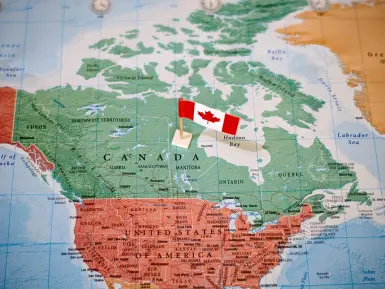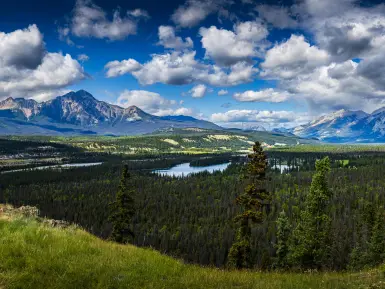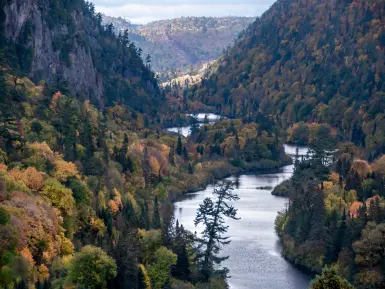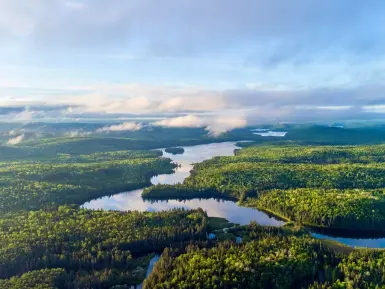Atlantic Canada is the coastline of Canada which borders the wild Atlantic Ocean, made up of the four provinces of New Brunswick, Newfoundland and Labrador, Nova Scotia, and Prince Edward Island. The ocean unites the four provinces, but each one promises a unique adventure.
The region is as scenic and beautiful as it is warm and welcoming. Atlantic Canada is characterised by colourful fishing villages, fresh seafood, sandy beaches and incredible marine wildlife. Everywhere you turn, you’ll find the friendliest locals who can’t wait to share their unique history and plentiful produce with you. And why wouldn’t they? With food like this and such a rich culture, they have a lot to be proud of.
Read on to find out why you really should add Atlantic Canada to your “must-see” list.
1. It has the freshest seafood

What: Hot, buttered lobster rolls, lobster by the pound and palm-sized scallops
Where: All four provinces
When: All year
Atlantic Canada is known for its fresher-than-fresh seafood, and for many, lobster is king. In Nova Scotia, pick up lobster rolls from seaside cafes along the Cabot Trail on Cape Breton Island, and the pick-your-own lobster from Hall’s Harbour Lobster Pound in the Annapolis Valley.
You can also join a lobster fishing boat to feel the spray on your face and the thrill of reeling in the lobster pots. There are plenty of excursions which let you catch your own and finish up with a clambake on the beach watching the sun go down.
In Prince Edward Island, traditional lobster suppers are served in community halls and church basements, with all of the trimmings including fresh baked bread, salads, mussels and homemade fruit pies.
In July, Shediac, New Brunswick celebrates the annual Lobster Festival. Visitors from around the world travel to Shediac, known as the lobster capital of the world for five days of fantastic seafood and fabulous entertainment.
Foodies will love Newfoundland and Labrador, of course known for fresh seafood served in fine dining establishments and local chippies, and also home to some very unique recipes like cod tongues and salt fish. Come on an empty stomach so you can experience everything.
2. It has some of the best whale watching

What: Humpback, minke, finback, pilot and North Atlantic right whales
Where: Bay of Fundy between New Brunswick and Nova Scotia, Cape Breton Island in Nova Scotia, Newfoundland and Labrador
When: Summer (June to September)
Up to 12 species of whale visit the Bay of Fundy over the summer months. The giants of the ocean are drawn to the rich feeding grounds where huge tides and estuary waters stir up nutrients and attract krill, squid, herring and other prey food in their millions. The most common whale species to spot include the (relatively) little minke whales and giant finback whales, the second largest in the world after the blue whale.
You can see whales from the shore sometimes but the best way to spot them is to join a sightseeing boat tour. Expert guides follow the whales’ movements and know the best spots to find whales feeding. A Zodiac (rib) boat offers a thrilling experience as it zooms over the ocean waves. A special treat is spotting the North Atlantic right whale which is the most engendered whale species in the world.
Newfoundland and Labrador boasts the world’s largest population of humpback whales, plus another 21 species of whales and dolphins, including the minke, sperm, pothead, blue, and orca. Between May and September, you can see them feed, frolic and even breach near the shores. Catching a single glimpse of these majestic mammals is an exciting and awesome experience, whether it's from the deck of a tour boat, the side of your sea kayak, or a seaside trail.
3. You can watch icebergs drift past your front door

What: Sections of glacier which have broken off Greenland and drifted down the Atlantic Coast
Where: Newfoundland and Labrador, along Iceberg Alley
When: Spring to early summer
From the coast of Labrador to the southeast shore of the island of Newfoundland, a very special waterway stretches, dubbed Iceberg Alley. The icebergs vary in colour from crystal white to deepest turquoise, and they aren’t just fantastic to look at. The locals here put the pure, 10,000-year-old ice to good use, brewing it in beer and distilling it in vodka and gin.
From towns like Battle Harbour, Twillingate, St. John’s and Fogo Island, you can stand at the shore’s edge as you watch these magnificent bergs drift by. To get up even closer to an iceberg, try a kayaking tour. We promise it will be an adventure you’ll never forget.
4. It has some of the best beaches

What: Pristine sandy beaches, red sandstone cliffs and blue surf
Where: All four provinces
When: Visit from June to September when the weather is warmest and all the amenities are open
With over 43,000 kilometers of coastline in Atlantic Canada, there’s something for everyone. The Northumberland Straight between New Brunswick, Nova Scotia and Prince Edward Island features the warmest saltwater for swimming in Canada.
The region has a variety of beach landscapes to explore, including white, sandy beaches, red sandstone cliffs, and stunning coastal cliffs. Build sandcastles, play beach volleyball, take a leisurely stroll and simply enjoy the serenity of days spent by the sea.
5. You can visit the world’s most photographed lighthouse

What: Peggy’s Cove Lighthouse
Where: Nova Scotia, in Peggy’s Cove
When: Year-round
One of the most iconic sights in Canada is the historic red and white lighthouse which rises from the rock at Peggy’s Cove. Built in 1915, the lighthouse still works today and is a fascinating place to visit along with the museum and gift shops.
Peggy’s Cove is only 40 km from Halifax so is an easy destination to get to if you fly into Nova Scotia’s capital city. Explore the rocky harbour front and treat yourself to a bowl of steaming chowder at the Sou’Wester or a homemade ice cream from Dee Dee’s.
6. You can watch record-breaking tides rise and fall

What: The biggest difference between high and low tide anywhere in the world
Where: New Brunswick, in the Bay of Fundy
When: Twice a day, year round
The Bay of Fundy is home to the highest tides in the world. In case you’re not sure how impressive that really is, picture this: the difference between high and low tide in some places can be an incredible 53 feet! Twice every day, the Bay fills up and empties a billion tonnes of water – more than the flow of all the freshwater rivers in the world combined.
A favourite way to witness the power of the tides is to visit Hopewell Rocks. These incredible rock stack formations teeter off the shore line. At low tide you can walk around the base of the rocks on the exposed sea bed. At high tide, kayak around the tops of the rocks for a completely new perspective.
7. You can witness the first sunrise in North America

What: The first sunrise in the most easterly point in North America
Where: Cape Spear National Historic Site, Newfoundland and Labrador
When: Sunrise all year round
Just a 20-minute drive outside the beautiful capital city of St. John’s, you’ll arrive at the most easterly point in Canada and all North America: Cape Spear National Historic Site. As such, it is here that dawn’s first rays touch the continent each morning. There are plenty of spectacular locations where you can view the sun creeping up over the ocean, from Signal Hill in St. John’s to our favourite vista of Cape Spear itself (all part of the Avalon Peninsula). Cape Spear Lighthouse perches on the end of the Cape at the continent’s most easterly point. It’s the oldest surviving lighthouse in the province so you get a fantastic dose of history too as you watch the sunrise.
Another favourite vantage point is Signal Hill National Historic Site. This historic site has a rich communications and military history, and thanks to its lofty perch, has unbeatable views.
8. You can be a part of literary history

What: The inspiration behind one of the world’s best-loved novel series
Where: Prince Edward Island, at Green Gables Heritage Place
When: Interpretation programs are offered from July to September
When Lucy Maud Montgomery wrote Anne of Green Gables in 1908, little did she imagine that millions of fans would still be watching, reading and visiting more than a hundred years later. Her warm and whimsical books followed the adventures of fictional red-headed Anne in the very real location of Prince Edward Island.
You can see those iconic green gables in Prince Edward Island National Park where you can explore the preserved house which inspired the books. The Avonlea Village is a recreated rural community based on the village where Anne lived and boasts eclectic shops and eateries. You can also learn more at the Anne of Green Gables Museum at Silver Bush.
So there you have it – eight of the best things to see and do in Atlantic Canada, though of course there are plenty more. For more information or inspiration to start planning your holiday, click here
Latest Articles

How big is Canada?


03/07/2025
A question that many people ask is ‘how big is Canada’? Most people know Canada is big, but just how big is big?

Canada Advocate Q&A: Trish & Cathie's Race Across The World Adventure


01/07/2025
Join us this Canada Day as we celebrate the breathtaking beauty of Canada with Trish & Cathie, the incredible winners of Race Across the World series 3! Discover Canada through the inspiring lens of two adventurers who truly fell in love with its majestic landscapes and vibrant culture.

Sault Ste. Marie Travel Guide: Undiscovered Canada


30/06/2025
Sault Ste. Marie in Canada is one of Ontario’s premier adventure towns, known for its rugged lakes, mountains, and world-class outdoor activities.

Algonquin Park Travel Guide: Iconic Canada


25/06/2025
Algonquin Provincial Park is one of Canada’s most spectacular wilderness regions. The park, which is Ontario’s oldest and largest provincial park, is filled with rocky ridges, fragrant maples and thousands of lakes.











